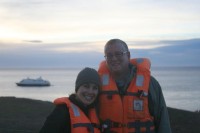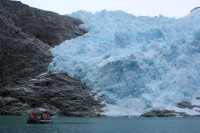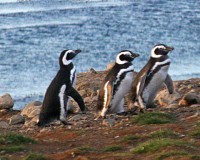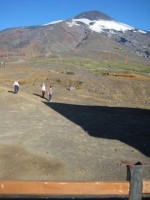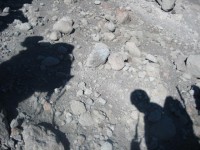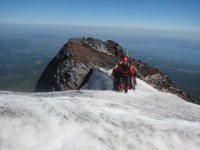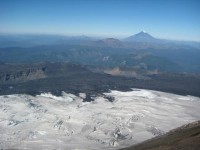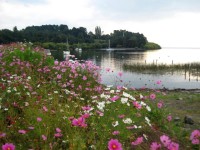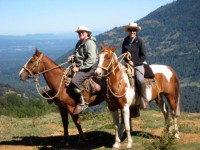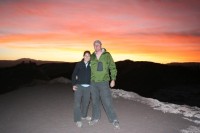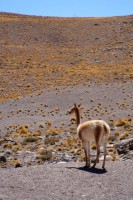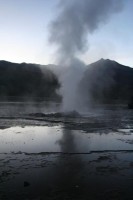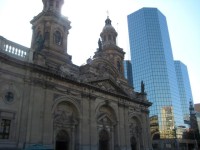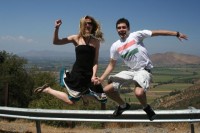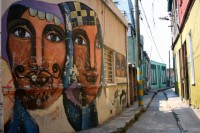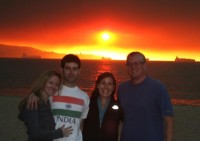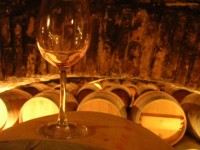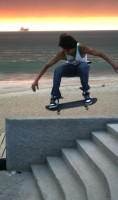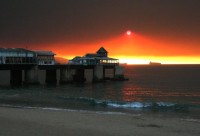Sun 20 Apr 2008
The Great[est] Outdoors
Posted by Shanna under Chile
No Comments
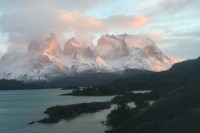
These days, when we meet new people and tell them how long we’ve been traveling, their first question is usually something along the lines of “What’s your favorite place been so far?” That’s an impossible question for us to answer; we’ve seen so many incredible places that we can’t pick just one. Even speaking in superlatives–the best, the worst, the prettiest, the most interesting–is generally impossible for us. Our visit to Patagonia’s Torres del Paine National Park, however, made superlatives fairly easy for once. Without question, Torres del Paine plays home to the most beautiful natural landscapes we’ve ever seen in our lives.
Surrounded by an eastern portion of the Andes that is known as the Paine mountain range, the 598,000-acre park is most famous for two sets of peaks–the Torres del Paine (“towers of blue”) and the Cuernos del Paine (“horns of blue”), neither of which actually look blue. Both the towers and the horns were formed when subterranean flows of magma got trapped under the earth’s surface and subsequently hardened into granite underground. Millions of years’ worth of erosion by snow, water and ice carved away the softer land that surrounded the hard stone and left the peaks standing alone in their majesty. Surrounding these formations are countless turquoise lakes (it’s apparently their color that inspired the “blue” moniker), golden fields, frigid glacial streams and the icy blue glaciers that feed them, endangered species like the guanaco (like the vicunas we met earlier in Chile, these guys are also cousins of the llama) and the occasional puma.

The park is nearly as hard to get to as it is gorgeous. About 70 miles away from the nearest large town, it’s hard for a lot of short-term visitors to see too much of it. Those with some time on their hands, however, can make the park their home for a few days, keeping in mind that they’ll need to either bring with them everything they’re going to need during their stay–there are no drug stores or snack shops to be found–or plan on partaking in the meals offered by the park’s small campgrounds and refugios. Or they can choose to spend their children’s college funds on a stay at the all-inclusive Hotel Salto Chico, which is run by a luxury resort operator known as “explora.” (The lowercase “e” should give you a clue as to how fancy its resorts are…) With apologies to our future children, we, err, made this last choice.
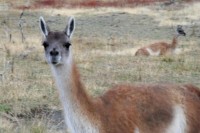
This was not your father’s stuffy luxury resort, folks. It was apparently started by a wealthy man who loved exploring the outdoors but wanted to return from his time in the wilderness to find a gourmet meal and four-star accommodations waiting for him. I’m sure it goes without saying that we enjoyed living his dream for four days. Each night, we met with one of the many professional guides on staff and decided on the next day’s adventure. And then, in the morning, we ate a fantastic breakfast and set off into the wild. We never had to consult a map; our guide always knew the way. We never had to pack a lunch; our guide had already done that for us. We felt a little spoiled, but after more than seven months of planning our days on our own, it was nice to turn the job over to someone else for a few days!
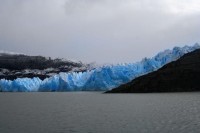
While the resort itself was incredible, the jaw-dropping mountain scenery we saw when we walked out the door blew it away. One day, we hiked to the Grey Glacier. The glacier is a frozen finger of the Southern Ice Cap, which is the largest body of ice in South America that’s still left over from the last Ice Age. The glacier looked to us like an immense river that had been frozen in time and like an incredible field of light blue meringue. (What can I say? I think we were pretty hungry by the time we reached the glacier…) House-sized chunks of bright blue ice recently separately from the glacier floated in the water nearby, making for an incredibly mystical landscape.

A few days later, we rode horses through crystal clear rivers in the company of gauchos whose families had been tending livestock on those grounds for generations. In another trip highlight, we hiked through rain, snow, wind and, ultimately, sunshine to the base of the Cuernos del Paine. The weather in the park changes so quickly that it’s often possible to experience each of the four seasons over the course of an hour. (“There’s no such thing as bad weather,” said our guide, “only bad clothing.”)
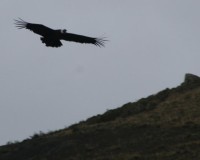
Another day, we wandered through the park’s vast plains or, as they’re called here, “pampas,” in search of wildlife. We were secretly hoping to see a condor, the gigantic bird (up to a ten-foot wingspan!) that is considered a symbol of health and power by many Andean cultures. We were told that such a sighting was fairly unlikely. In keeping with the incredible luck that we’ve had for most of this trip, we saw not one, but fourteen condors. Sitting on top of a huge rock in the middle of what could very possibly be the most beautiful land on earth, watching condors soar just above our heads, we felt very lucky, indeed.
[embedplusvideo height=”350″ width=”450″ editlink=”http://bit.ly/1mFHHJa” standard=”http://www.youtube.com/v/sHVyianpvHw?fs=1″ vars=”ytid=sHVyianpvHw&width=450&height=350&start=&stop=&rs=w&hd=0&autoplay=0&react=1&chapters=¬es=” id=”ep6663″ /]
[embedplusvideo height=”350″ width=”450″ editlink=”http://bit.ly/1mFHNQY” standard=”http://www.youtube.com/v/p75OThiTb_0?fs=1″ vars=”ytid=p75OThiTb_0&width=450&height=350&start=&stop=&rs=w&hd=0&autoplay=0&react=1&chapters=¬es=” id=”ep3087″ /]
